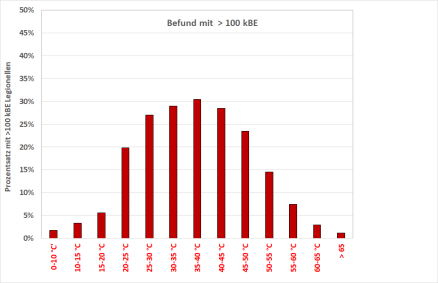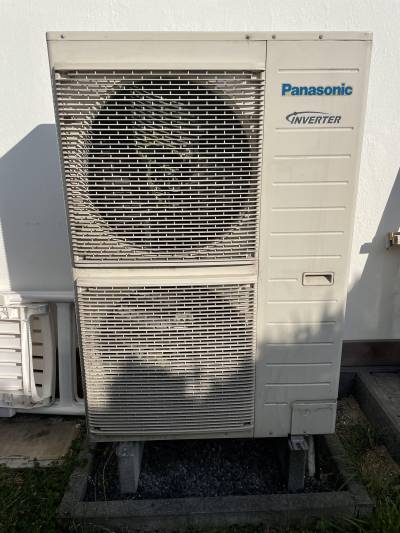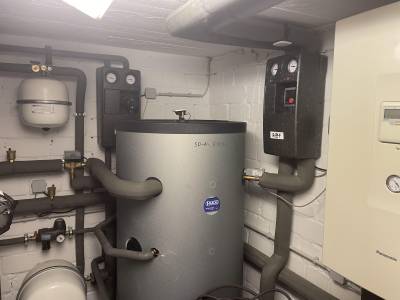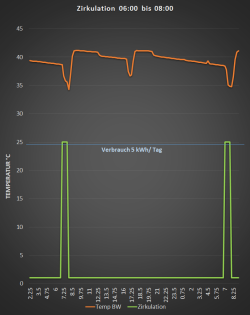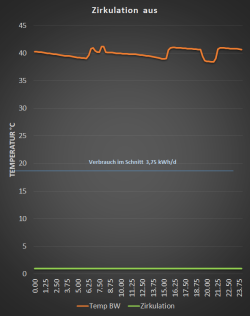Table of Contents
Circulation system
More exactly, our topic here is domestic hot water circulation (DHW). It was originally introduced to improve the comfort of using hot shower water. If a hot water pipe of the distribution system has a length of a few metres up to the point of use (often this may be 10 to 20 m), then a few litres of water may already be present in such a pipe - of course this water cools down to room temperature if it remains unused for a longer period of time. This is the “cold water” that comes out of the shower at first, and it may take up to a minute until a comfortable temperature is reached. Of course, this is also associated with the corresponding loss of water if this cold water is simply “disposed of” through the drain. The resourcefulness of engineers is not especially strained here as this is technically easily remedied, but the installation effort for it is quite considerable 1). Another heat-carrying pipe is routed from a point as near the point of use as possible back towards the heat source (usually a storage tank), this is called the circulation pipe. If we now add a pump in this pipe which brings the water in this pipe back to the storage tank, and which is constantly in operation, then all the water in this circulation loop will remain close to the temperature of the storage tank with an adequate flow rate. We will then get really hot water as soon as we open the faucet. It is undeniable that this will also save water (preliminary flow of cold water mentioned above).
| It is often claimed that this also saves energy: but that is not necessarily correct, because if pipes are poorly insulated they will lose heat constantly due to the now higher temperatures; heat must be additionally supplied by the hot water generation system; we refer to these as circulation losses. In the case of really well-insulated pipes, these losses may be very high: we have therefore provided instructions here for improving the thermal insulation of pipes carrying hot water. In principle, we could greatly reduce these losses through excellent insulation and a little attention with regard to the length of the distribution system, as was done e.g. in the case of the Passive House prototype in Darmstadt Kranichstein (picture). This is very worthwhile by the way, as the expenditure is significantly lower than the total cost of energy incurred annually for compensating such losses. |  The four 2) heat-carrying pipes here have initially been insulated individually as usual. The entire set of pipes was then enclosed in 100 mm thick insulation; the costs for this were actually very small, the losses are reduced by more than half again. However, it is clear that this must be planned for new builds, and cannot be retrofitted so easily in this perfect way in the case of existing pipes. The four 2) heat-carrying pipes here have initially been insulated individually as usual. The entire set of pipes was then enclosed in 100 mm thick insulation; the costs for this were actually very small, the losses are reduced by more than half again. However, it is clear that this must be planned for new builds, and cannot be retrofitted so easily in this perfect way in the case of existing pipes. |
However, legislation specifies that a far lower standard of pipe insulation is legally adequate; unfortunately, often not even this standard is adhered to in practice 3). Ultimately, today on average around half (!!) of the energy consumption of the central hot water generation system is attributable
to the heat losses of the circulation system. Hardly anyone is actually aware of this; this is an example
of high energy consumptions due to replacing of the heat losses in our society that is used to
comfort4)
As long as gas and oil are really cheap, our society doesn't normally concern itself with 'such details' at all. We leave this to the experts and firmly believe that this is already done in the most optimal way. Many people are then really surprised that in reality it isn't at all true, that a major proportion of the energy consumption that we consider essential serves exclusively to compensate for the losses that are actually (easily) avoidable. This is not only true for hot water: we will present this in more detail in an article on the energy service.
The legionella shock
However, in the specific case of hot water circulation, on 21 July 1976 another reason, now considered decisive, was identified: about 2000 legionnaires came together for Independence Day celebrations at the Bellevue-Stratford Hotel in Philadelphia. 182 of these persons fell ill with an unknown form of pneumonia, and 29 of them died. The cause was later identified as a bacterium known as 'Legionella pneumophila' which proliferates in systems containing warm water and which in that specific case had spread via the air conditioning system of the hotel. Ideal conditions exist for the proliferation of these pathogens in standing water in building services installations (particularly air conditioning and in less frequently used water pipes) with temperatures between 35 °C and 45 °C (see table).
For this reason, the Drinking Water Ordinance (German only) was issued in Germany. The regulations adopted here correspond with the latest scientific and technological standards and also form the basis of our recommendations. We expressly point out that “Corresponding facilities in single-family houses and apartment blocks do not count as large-scale systems for heating drinking water”. From a purely legal point of view, every owner-occupier of a house or apartment can thus actually do what they wish provided that there are no tenancies. Of course, this does not mean that there is absolutely no risk at all with “small-scale systems”: proliferation of legionella bacteria naturally always follows the same biology. However, if all water in the system is renewed within about one to two days, then the danger is already greatly reduced. It is particularly important to avoid pipes etc. in which the water remains standing permanently for longer periods of time (referred to as the dead volume, for which even circulation is usually of little help, even if this is operated at 60°C). If someone wishes to reduce the risk relating to legionella, they are advised to consult a qualified and competent energy consultant.
Practical experiences
Many small-scale systems in single-family houses operate circulation pipes with temperatures lower than the recommended 60°C. Systems which are supplied by heat pumps in particular often have lower hot water temperatures; if these are in the range 35 to 45 °C, then optimal conditions will prevail for the proliferation of legionella bacteria in such systems - operation of the circulation will not make much difference then. It continues to be useful to move the water around at least for a couple of hours each day to avoid prolonged stagnation of the water. Otherwise operation of the circulation system will serve only to provide the convenience of hot water.
Note: protection against legionella can be improved here by installing an electric heating clamp (500 to 800 W) equipped with a timer and a thermostat: the electric heating clamp is installed on the drinking water supply pipe as close as possible to the storage tank and insulated well, of course. For regulation, the temperature (suggested: 62°) is measured at the pipe a few metres in the direction of flow (naturally also insulated here); the pipe clamp with a setpoint of 62°C and the circulation pump (24 litres/h) are then operated once a day via the timer, 1 h before the use of the bathroom in the morning. Once a week this thermal disinfection is operated over 12 h, in order to heat up the entire volume of the hot water storage tank completely. This is known as a legionella circuit, but is often very expensive.
Legionella filter
One method of avoiding infection with legionella bacteria during showering is to use shower heads with a built-in legionella filter. (The science of hygienics speaks of) Hygienists speak of “terminal filters” here, which are inserted in airtight sockets/mounts immediately before actual usage. In this way it can be ensured that contamination does not occur after passing the filter. We have examined these shower heads in more detail and presented our experiences in the section on water-saving shower heads. This approach does indeed seem to work well. If anyone wishes to operate a circulation system at temperatures that are suitable for heat pumps ranging from 40 °C to 50 °C even in a single-family house, or if anyone wishes to switch off the circulation system temporarily (e.g. during the daytime when no-one is at home, or from midnight till 4 in the morning), they would be well-advised to use such shower heads with a legionella filter in order to keep the risk to a minimum.
Reducing heat losses of the circulation system
Insulating heat-carrying pipes well is always advantageous and reduces the risk of legionella at the same time. In subsequent insulation of pipes, we have described exactly how this is done.
Moreover, some users of systems in single-family houses have also experimented with the operation modes of their circulation system. At this point I would especially like to thank René Schlenker, who sent us the measured results documented below.
This relates to a hot water system in a single-family house, the central heat generator is a heat pump (pictures).
This system was in operation from May 2022 exclusively for the domestic hot water supply of a house with four occupants. René Schlenker has been reading the electricity meter and evaluating the respective electricity consumption values manually since this time. In doing so, he tested 3 modes of operation: 1) continuous operation of the circulation system (as the system was originally set) 2) circulation only in the time before and during use of the shower for comfort reasons 3) operation completely without circulation.
These measured results confirm very well the (among experts well-known) fact that today the circulation losses of average systems account for around half of the annual consumption. Of course, there are still tap losses and heat storage losses even after the circulation system is switched off.
In the present case, the losses are lower solely because the water temperatures are nearer 40 °C rather than 60 °C.
The hot water systems commonly used today “work” predominantly for compensating the heat losses of the systems. These can be reduced especially by much better insulation of the pipes and more attention to airtight execution of the insulation of heat storage tanks. If precautions are taken with regard to hygiene, reducing the temperatures to the actually required level for usage and intermittent operation of the circulation can also be considered.

